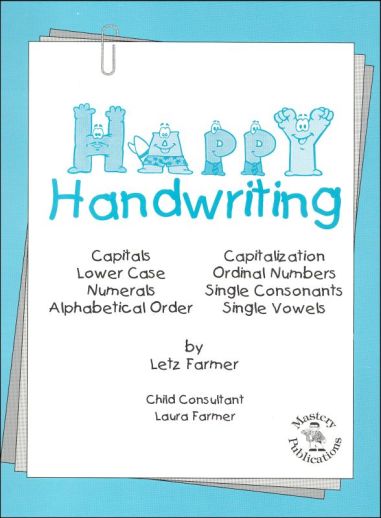We use cookies to make your experience better. To comply with the new e-Privacy directive, we need to ask for your consent to set the cookies. Learn more.
Happy Handwriting
We try to be pragmatic at our house and in our business - whatever works well, whatever makes sense, that's what we try to do. I've not met Letz Farmer, the author of this book, but I'll bet she's a pragmatist also. Lots of practical, "that makes sense", ideas are included in this ball-and-stick method. For example, capital letters are taught first to minimize reversals that can occur in lower case letters (I thought Mark would never get "b" and "d" straight). Capital letters are taught according to "stroke families"; letters with only vertical and horizontal strokes are taught first; letters with slanted strokes are taught next; finally, letters which have a circular component are taught last, because these are the hardest. The first lower case letters taught are the ones that look exactly like their capital counterparts; next, the ones that look similar to their capital counterparts; and last, the ones that look nothing like their capital counterparts. Practice pages contain three lines for each letter; letters on the first line are thick and fully shaded, and show directional arrows for the starting point and direction of strokes; letters on the second line are thick outlines that allow for some "wiggle" as the child attempts to write his letter inside the outline; the third line is blank and allows the child to make his letters freeform. The book has a fold-flat plastic binding so that the student is not fighting a hump in the page as he attempts to print his letters. Each pair of pages is laid out so that the top of the pair is at the left-hand side as you open the book; when in its upright position, either right-handers or left-handers can use the book without disadvantage.
Several other niceties are incorporated. A short story and cute illustrations help the child to remember each letter. The bottom of each practice page contains the alphabet, but missing some letters so the child can write them in the appropriate place. Phonics practice and (here's a first) sign language is incorporated if you want to use these along the way. Plus, Bible verses are used as part of each exercise.
Where did Mrs. Farmer come up with all these good ideas? She credits her "child expert", daughter Laura. Nice job, Laura!
These materials span grade levels and include both instruction and practice.
| Product Format: | Softcover Book |
|---|---|
| Grades: | K-2 |
| Brand: | Mastery Publications |
| Author: | Letz Farmer |
| ISBN: | 9780929223100 |
| Length in Inches: | 11 |
| Width in Inches: | 9 |
| Height in Inches: | 0.5 |
| Weight in Pounds: | 0.9 |
Scripture verses are printed in this book. It does not state what version, but similar to NIV? However, this is not a Scripture verse copy book. It is a workbook that you can use to teach handwriting to your child, not to keep them busy with copy work. It is especially designed for students that may have special needs, but does not have to be specific to them. Our kids have enjoyed this book, both those with special needs and those without.


Mrs. Letz Farmer was wonderful at creating curricula for children with special needs and for those who struggle in school. I have used her math along with Saxon for over 20 years. The math is no…
used with older child, fun, solid, just enough practice, not too much, everyone is happy :)
This looks exactly what I need!
I have a Kindergartner who has only practiced handwriting in dry-erase books. He likes to invent his own ways of forming letters instead of following the directions, so I hunted up what I hope is a…